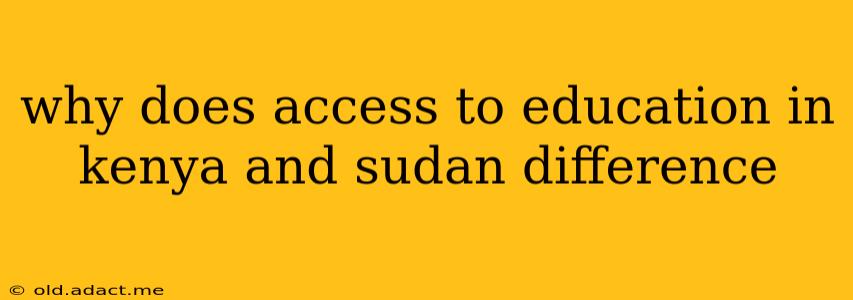Why Does Access to Education Differ in Kenya and Sudan? A Comparative Analysis
Access to education in Kenya and Sudan, while both facing significant challenges, differs markedly due to a complex interplay of political, economic, social, and geographical factors. Understanding these disparities requires a nuanced look at each nation's unique context.
Historical Context and Political Stability:
Kenya and Sudan have vastly different histories impacting their educational systems. Kenya, while experiencing its own political challenges, has enjoyed relative political stability for a longer period compared to Sudan. Sudan's prolonged history of civil war, conflict, and political instability has severely disrupted education infrastructure and created a climate of insecurity, hindering educational progress. This instability directly impacts funding, teacher recruitment and retention, and the safety of students and educators. Kenya, while not without its own internal conflicts, has seen greater sustained investment in education, albeit unevenly distributed.
Economic Disparities and Funding:
Economic disparities significantly contribute to the education gap. Kenya's economy, while not without its struggles, is generally more developed than Sudan's. This leads to greater government revenue available for investment in education, though challenges remain in ensuring equitable distribution across regions and socioeconomic groups. Sudan's struggling economy severely limits its ability to allocate resources to education, resulting in underfunded schools, a lack of resources (textbooks, equipment), and inadequate teacher training. The difference in per capita GDP directly reflects in the resources dedicated to education.
Geographical Factors and Infrastructure:
Geographical challenges further complicate the situation in both countries. Kenya's varied topography presents difficulties in providing access to remote areas, but infrastructure investment, while still inadequate, has been relatively higher than in Sudan. Sudan, a vast country with significant desert regions and conflict-affected zones, faces enormous logistical hurdles in providing access to education in remote and marginalized areas. Limited infrastructure, including roads and communication networks, makes reaching these areas and delivering educational resources extremely difficult.
Social and Cultural Factors:
Social and cultural factors also play a crucial role. While both countries have made strides in promoting girls' education, significant gender disparities remain. Cultural norms and practices, particularly in certain communities, can hinder girls' access to education. Poverty further exacerbates the issue, often forcing families to prioritize immediate economic needs over education, especially for girls. In Sudan, deeply ingrained tribal and religious beliefs can influence access and the type of education offered.
H2: What are the biggest challenges facing education in Kenya?
Kenya's biggest educational challenges include:
- Unequal access: Disparities in access to quality education exist between rural and urban areas, and between different socioeconomic groups.
- Teacher shortages and training: A lack of qualified teachers, especially in rural areas, significantly impacts the quality of education.
- Overcrowded classrooms: Overcrowding in many schools hinders effective teaching and learning.
- Curriculum relevance: Ensuring the curriculum remains relevant to the needs of the 21st-century job market is a persistent issue.
H2: What are the biggest challenges facing education in Sudan?
Sudan faces even more severe challenges, including:
- Conflict and displacement: Prolonged conflict and displacement have decimated educational infrastructure and disrupted the education of millions of children.
- Extreme poverty and lack of resources: Extreme poverty limits families' ability to afford school fees, uniforms, and other essential supplies. Schools often lack basic resources like textbooks and clean water.
- Gender inequality: Girls' access to education is significantly lower than boys'.
- Lack of qualified teachers: A severe shortage of qualified teachers exacerbates the already dire situation.
H2: How does the government of Kenya support education?
The Kenyan government supports education through various initiatives including free primary education, subsidized secondary education, and investment in educational infrastructure. However, challenges remain in ensuring equitable access and quality across the country.
H2: How does the government of Sudan support education?
Sudan's government struggles to provide adequate support due to its economic and political instability. While there are government programs aimed at providing education, funding and implementation remain severely limited.
Conclusion:
The differences in access to education in Kenya and Sudan are multifaceted. While Kenya faces significant challenges, its relative political stability and greater economic capacity have allowed for comparatively more investment in education compared to Sudan. Sudan's protracted conflict, economic struggles, and deeper-seated social and cultural barriers present immense obstacles to providing equitable and quality education for its population. Addressing these challenges requires sustained investment, political will, and a commitment to inclusive and equitable educational policies in both nations.
